Australian Pulse Bulletin
Minimising frost damage in pulses
Frost risk is difficult to manage in pulses, however some key management strategies may reduce the risk or extent of damage. These strategies include:
- Know the topography, and map areas of greatest risk so that they can be managed to minimise frost damage.
- Choosing the right crop type, crop variety and sowing time can help reduce exposure or impact at vulnerable growth stages.
- Carefully assess the soil type, condition and soil moisture levels, along with stubble and canopy management.
- Correct crop nutrition and minimised crop stress can influence the degree of frost damage.
Modifications to conditions over large areas are required to reduce frost risk. Small changes in management can have a big impact because frost damage occurs at specific 'trigger' temperatures. Keeping the air temperature even 0.1°C above the critical ‘trigger’ point will avoid frost damage. Air flow through the canopy can also have a positive impact towards avoiding frost damage. If the frost is severe, below the ‘trigger temperature’, damage occurs regardless of management, so then avoidance becomes important.
The soil is the heat bank, and it is desirable to have warm soil so that warm air can rise at night to minimize frost risk. The crop canopy will trap cold air on top, so a dense canopy is not necessarily desirable.
-
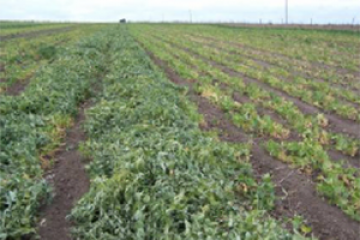
Frosted pulses make excellent quality forage
-
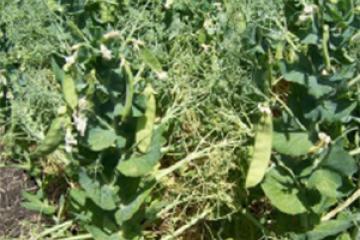
Frosted field pea pods
-
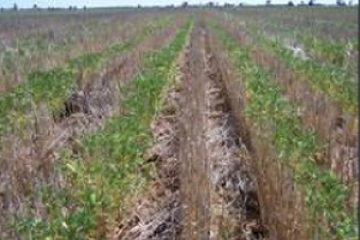
Lupins sown into standing cereal stubble
-
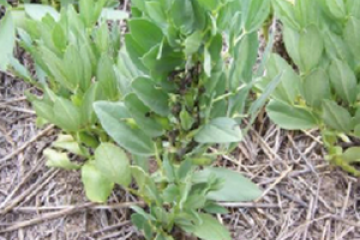
Frosted bean pods
-
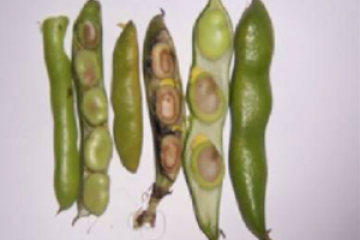
Late frosted bean grain
Problem areas and timings
Mapping or marking areas identified as frost-prone will enable growers to target frost and crop management strategies to these high-risk areas. Knowing when the period of greatest probability of frost risk occurs is also important for crop management.
Crop and sowing time
Strategies to minimise frost damage in pulses work in combinations of either: growing a more tolerant species; trying to avoid having peak flowering and early podding during the period of most risk; extended flowering to compensate for losses to frost; or ensuring that most grain is sufficiently filled to avoid damage when frost occurs (see table). Targeting flowering and early podding to periods of least frost risk (lowest probability) is achieved through combinations of sowing date and variety choice based on flowering time and flowering duration. Local experience will indicate the best choices.
Late flowering targets avoidance of early frosts, but in the absence of frost may also reduce yield potential due to moisture deficiency or high temperatures. Very early flowering can allow pods to be sufficiently developed to escape frost damage, and ensure some grain yield at least before a frost occurs. Increased disease risk needs to be considered with early sowing.
Variety and crop choice
Pulse species and varieties differ in their frost susceptibility and risk exposure times (see table), so choose wisely for the situation.
| Frost tolerance of pods & seeds | Commencement of flowering | Length of flowering (duration) | Example variety | Frost tolerance or avoidance 'mechanism' | |
|---|---|---|---|---|---|
|
Beans# |
medium |
early |
long |
PBA Zahra, PBA Samira, Farah, Nura |
Grain tolerance, early podding and seed fill |
|
Chickpeas |
low |
medium |
medium |
Genesis 090 |
Avoidance (escape early frosts), flower in heat |
|
|
late |
short–medium |
Almaz, Nafice |
Avoidance (escape early frosts), flower in heat |
|
|
Lupins# |
low–medium |
very early–early |
long |
Mandelup, Wonga |
Compensation with later podding |
|
late |
short–medium |
PBA Jurien, Jindalee, PBA Barlock |
Avoidance (early frosts), some late podding compensation |
||
|
Lentils |
low |
medium |
medium |
PBA Hurricane, PBA Jumbo2 |
Some avoidance (early frosts), sowing date, short crop height a disadvantage |
|
Peas* |
very low* |
early** |
long |
PBA Hayman, Parafield, Sturt |
Extended flowering, early podding, lodging |
|
late** |
short |
Kaspa*, PBA Wharton |
Possible avoidance (early frosts), quick flowering |
||
|
early** |
short |
Excel*, PBA Twlight, PBA Percy |
Possible avoidance (late frosts), early podding |
||
|
late** |
medium |
Morgan, Mukta |
Avoidance (early frosts), lodging |
||
|
Vetch## |
very low |
early |
long |
Rasina, Languedoc |
Extended flowering, some later compensation, possible avoidance (late frosts), lodging |
|
|
late |
short |
Morava, Blanchfleur |
Possible avoidance (early frosts), lodging |
# Beans, lupins are usually sown early.
* Erect, semi-leafless peas may be more frost susceptible in the field than conventional, lodging types.
** Damage from traffic or herbicides on frosted peas during pre-flowering stages can leave the peas more vulnerable to spread of the disease bacterial blight, particularly on some semi-leafless, erect types.
## Vetch is a multi-purpose forage and grain crop that enables flexibility of use.
Spread the risk
Match different pulses to risk areas by sowing a different variety or species into targeted areas within the same paddock. Matching the crop, variety, sowing date and subsequent inputs to the frost risk location spreads the risk.
Have forage as an optional use. Designating hay or forage as a possible optional use for the pulse in high frost-risk paddocks provides flexibility.
Mixing two pulse varieties (long and short season, tall and short etc) balances frost risk with the risk of end of season drought, and reduces the risk of losses from any one frost event. Multiple frost events can damage both varieties. If grain from both varieties is not of the same delivery grade, then only the lowest grade is achieved. The only realistic, practical options are in peas, narrow leafed lupins, kabuli chickpeas, and perhaps desi chickpeas. Flowering time differences are minimal in lentils and beans.
Sowing a mixture of pulse species is feasible, but not common. Complications in crop choice include achieving contrasting grain sizes, herbicide requirements, harvest timing and grain cleaning. Multiple frost events can occur that may damage both crops. Pulses grown in a mix will be suitable for feed markets only unless they can be cleaned to enable purity in segregation. If these difficulties can be overcome there is an opportunity for alternate-row sowing of different pulses.
Reduce frost damage
Minimise input costs to reduce financial risk exposure in frost-prone paddocks. Bear in mind though, that reducing inputs may reduce financial exposure and assist grain gross margins when crops are hit by frost, but can lessen the chance of a successful hay cut or jeopardize the crop if no frost occurs.
Manage nodulation and nutrition. Ensure pulse crops are adequately nodulated and fixing nitrogen. Ensure pulses have an adequate supply of trace elements and macro-nutrients – (supplying high levels is unlikely to increase frost tolerance). Crops deficient or marginal in potassium and copper are likely to be more susceptible to frost damage, and this may also be the case for molybdenum. Foliar application of copper, zinc or manganese may assist, but only if the crop is deficient in the element applied.
Canopy management. A bulky crop canopy, and exposure of the upper pods may increase frost damage. The pulse canopy can be managed. Semi-leafless, erect peas may be more vulnerable than conventional, lodging types because their pods are more exposed. A mix of two varieties of differing height, maturity and erectness may also assist in reducing frost damage.
Sow in wider rows, so that frost is allowed to get to ground level, and the inter-row soil is more exposed. An open canopy does not trap cold air. Wide rows require the soil to be moist to trap the heat in the soil during the day. With wide or paired rows and a wide gap, the heat can radiate up.
Channel cold air flow away from the susceptible crop by using wide rows aligned up and down the hill or slope. A sacrifice area may be required where the cold air settles.
Cereal stubble presence provides a cooler soil and root zone, worsening the frost effect compared with bare soil. Standing stubble is considered less harmful than slashed stubble as less light is reflected and the soil is more exposed to the sun. Dark coloured stubble will be more beneficial than light coloured.
Rolling can help keep soils warm by preventing soil moisture loss, but not necessarily on self mulching or cracking soils. Note that press wheels roll only in the seed row, but not the inter-row. With no-till practice, avoid having bare, firm moist soil as it will lose some of its stored heat.
Claying or delving sandy soils increase the ability of the soil to absorb and hold heat by making the soil colour darker, and retaining moisture nearer the surface.
Higher carbohydrate level in the plant during frost leads to is less leakage during thawing. Biological farmers measure sugars in the plant sap ('Brix' reading). A higher sugar content (high Brix) will also have a lower freezing point, and associated protection against frost damage. The effectiveness of various products applied to soil and plant to increase plant carbohydrates is unknown.
Better varieties coming. The GRDC is investing through Pulse Breeding Australia in gerplasm enhancement and pulse variety breeding for frost tolerance, including altered flowering time and duration to avoid frost; and screening of pulse varieties for relative levels of frost tolerance in the field. New varieties will be released when available.
See also
This publication was produced from information gathered on pulses by Wayne Hawthorne (formerly Pulse Australia) and information published for cereals by Knell et al (2006).
Key contacts
Disclaimer
Information provided in this guide was correct at the time of the date shown below. No responsibility is accepted by Pulse Australia for any commercial outcomes from the use of information contained in this guide.
The information herein has been obtained from sources considered reliable but its accuracy and completeness cannot be guaranteed. No liability or responsibility is accepted for any errors or for any negligence, omissions in the contents, default or lack of care for any loss or damage whatsoever that may arise from actions based on any material contained in this publication.
Readers who act on this information do so at their own risk.
Copyright © 2015 Pulse Australia
All rights reserved. The information provided in the publication may not be reproduced in part or in full, in any form whatsoever, without the prior written consent of Pulse Australia.
Last updated: 20 November 2015
